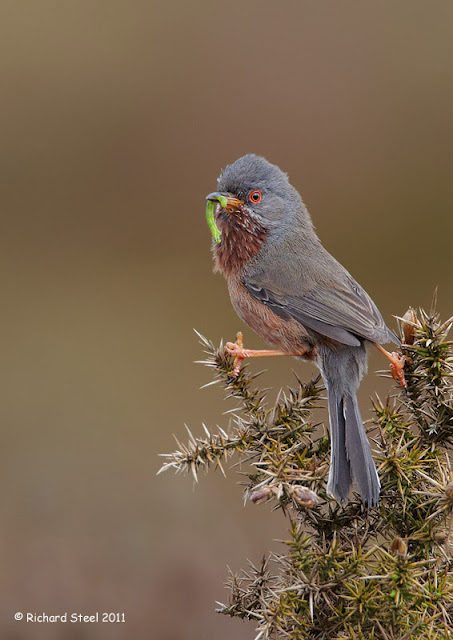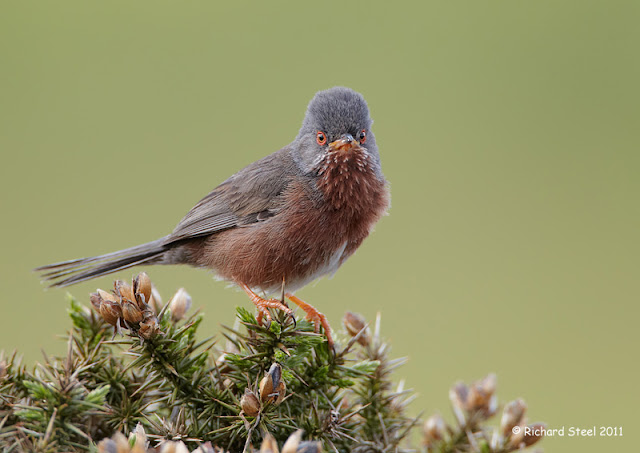I remember, from my childhood days of flicking through bird books, being fascinated by the unusual looks Dartford Warbler which was described as a rare and secretive bird. Move forward in time to the present and it became a species that came high up on my ever expanding list of birds to see and photograph.
The Dartford Warbler is a rare bird in the UK where it is at the extreme northern edge of it geographic range and generally confined to the south of the country. A bird that thrives in the warm climates of the Mediterranean suffers when harsh winter condition prevail here as the population is non-migratory. It was estimated that the after the harsh winter of 1962 there were only 10 pairs left. Numbers have since recovered to around 3000 pairs, no doubt helped by an ever warming climate and careful maintenance of its healthland habitat. Given the tentative hold of this species in the UK it has rightly been afforded Schedule 1 status. From a photographer point of view this means that a permit is required to photograph birds near the nest.
My first encounter with what is probably the most colourful warbler species in the UK, came back in 2010 when I had to make a journey to the south coast for a couple of days for the unfortunate business of a funeral for someone who had unexpectedly passed on well before their time. I had decided that on the day following the funeral, I would head out at first light with the camera as a bit of therapy to forget the sadness of the day before. I trawled the internet for information for somewhere to go in an area I didn't know and it appeared that a nearby area of heathland held a small population of Dartford Warblers. I knew from my reading that the best chance to see one of these skulking birds was in early spring when males would sing from the top of low gorse bushes and healthland scrub to attract a mate. Well the timing was right at least and pre-nesting time would remove the need for the Schedule l licence, the only task that remained was actually finding one!
I arrived at my chosen area just as the early morning sun was peeking above the horizon and filtering through the early morning mist. As the mists started to clear so did my confidence as spread out before me was hundreds of acres of low gorse bushes. Finding the bird could be trickier than I thought. Anyway I set off towards a low ridge line where most of the birds had been sighted in the old reports. After quite a bit of wandering round I heard an unfamiliar scratchy warbler and to my disbelieve a beautiful looking male, bathed in early morning light, appeared on a bush next to me and started singing.
If you want to see one in action I have found this clip on YouTube Dartford Warbler video. The illustrations in my childhood books really had not done this beautiful bird justice but I was quite surprised how much smaller the bird was than the image in my head. In fact it was tiny which no doubt does not help it plight in cold weather. I stayed with the bird for about an hour until a female appeared in response to his constant song.
My second encounter with Dartford Warblers unexpectedly happened much closer to home. The nearest and mostly northerly population is a few bird in the Midlands region. During the very cold winter of 2010 / 2011 it appears one of the male birds was displaced in its search for food to an upland area in North Wales. This bird quickly became popular with photographers, and as I tend to avoid the crowds, I only visited when it had gone quiet again when it was assumed the bird had disappeared. However, this was not the case. The need for the Schedule 1 Licence was not necessary for a non-breeding solitary male but I still sought permission to photograph the bird from the authorities in the late spring period. I undertook two visits to take some photograph and quickly located the bird from the now characteristic song as it flitted between low bushes and gorse.
Interestingly during my second visit the bird was collecting large numbers of caterpillar and feeding them to an 'adopted' brood of recently fledged Common Whitethroat which are from the same family of Sylvia warblers. I guess the bird, having unsuccessfully found a breeding mate, found it hard to ignore the incessant chemical call of the hormones driving its paternal instincts.
Who knows when my next encounter with one of these special birds will be? It may not be for many years but if it does happen I will cherish every moment spent in close proximity to this fascinating little warbler.









Fabulous little bird, not to mention the quality of yours pics! WOW!
ReplyDeleteI would love to only see it! :)
Congratulations Richard!
Bonitas fotos de esta Curruca rabilarga,enhorabuena.Saludos
ReplyDeleteGeweldige foto's van deze prachtige vogel.
ReplyDeleteKwaliteit is helemaal super.
Groetjes Irma
Great shots!!!!!!!!!!
ReplyDeleteRegards,
Your pictures are unbelievable! I love the cute tuft on its head.
ReplyDeleteThese images and the warbler are gorgeous Rich!
ReplyDeleteWhat fantastic photos ! I don;t think I was even aware that this species existed, but I look forward to seeing it in the wild one day. I have done a fair amount of birding in the Middle East, which serves as a kind of avian cross-roads for African, European and Asian species, but I haven't come across this bird before. I recently started a natural history website which might be of interest to you:
ReplyDeletewww.newenglandnaturenotes.blogspot.com
It focuses mainly on the wildlife and ecology in the six US states of New England, but I'm also incorporating ideas and information from my travels throughout the US and abroad. Let me know if you'd like to do an interview about your site sometime - I think my readers would be curious to know about birding across the pond, as it were.
You can reach me via email at newenglandnaturenotes@gmail.com
Thanks,
Daniel E. Levenson
Editor,
New England Nature Notes
your determined pursuit of this beautiful bird was well rewarded. Excellence in your photographic prowess is displayed most predominantly also. Well done, a lovely reward for your patience; thanks for sharing
ReplyDeleteWhat a wonderful looking bird.
ReplyDeleteInteresting post and splendid images!
ReplyDeleteGreat images, Richard. I've seen far fewer of these in Wales after the harsh winters we've had here recently.
ReplyDeleteOh my goodness, the Dartford Warbler is a most beautiful bird! How fortunate you were to see these beauties on two occasions. Fabulous post, exquisite photographs!
ReplyDeleteMany thanks for the comments :)
ReplyDeleteThat is quite a tale and what an interesting and comical looking little bird it is!
ReplyDelete